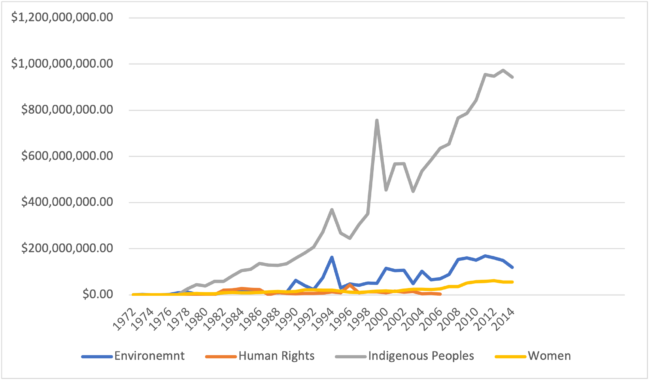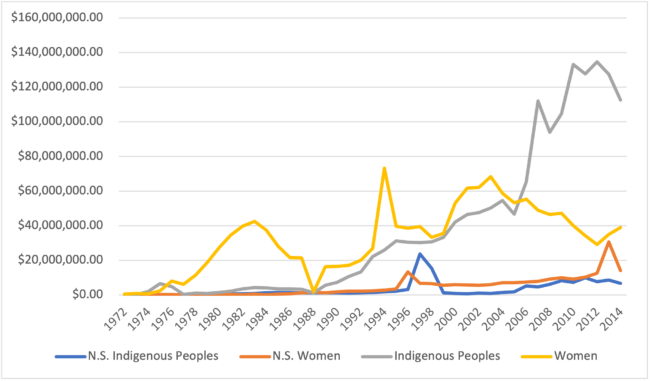Trends in Local and National Funding
| Copyright Dominique Clément / Clément Consulting
This posting first appeared in The Conversation.
Canada has one of the largest nonprofit sectors in the world. It accounts for at least 6.8 per cent of GDP and employs 12 per cent of the country’s working population (third overall after retail and manufacturing). And more than most other countries, the nonprofit sector in Canada relies on government funding. Yet there is a shocking lack of transparency in state funding for the nonprofit sector.
The State Funding for Social Movements project used access to information laws and other tools to collect grants data from the Federal, British Columbia, and Nova Scotia governments for environmental, human rights, Indigenous peoples, and women’s issues. We identified several concerning trends: inequities in federal funding among jurisdictions; vast disparities in funding among provinces and municipalities; a lack of sustainable funding for nonprofits; and a funding landscape that privileges a small number of organizations.
The Problem with Federal Funding
There has been a significant increase in federal funding in these four sectors over time. Women’s issues received $55.8 million in 2014 alone compared to $17.3 million in 2000. Funding for the Indigenous peoples’ sector more than doubled from $450 million to nearly $1 billion. The problem, therefore, is not necessarily a lack of funding. It is shifting priorities. Federal funding for human rights has declined while funding for environmental issues has increased only incrementally since 2000.
Federal Transfer Payments to Nonprofits in Four Sectors, 1972 to 2014 [Source: Public Accounts]

Ontario receives a vastly disproportionate amount of federal grants. From 2000 to 2014, organizations in these four sectors received $3.3 billion compared to less than $1 billion in Quebec. In the women’s sector specifically, nonprofits in Ontario were granted over $380 million, which was more than double the combined amount of funding in the every other province and territory in that sector.
There are also notable disparities among cities. Nonprofits in Winnipeg received less federal funding than Ottawa but far more than Toronto or Vancouver (in part because of the larger number of Indigenous peoples’ organizations in that city). In the women’s sector, nonprofits in Toronto and Ottawa received more federal grant funding than the next fifty cities combined.
These disparities matter. The quality of essential public services, from employment training to sexual assault centres, are impacted by the availability of funding. Yet these services are as essential in Moncton or Regina as they are in Toronto.
Disparities in Provincial Funding
The nonprofit sector relies primarily on provincial governments, which provide the bulk of funding for nonprofit organizations that provide public services. Most organizations are local rather than national. And provincial jurisdiction more often overlaps with the nonprofit sector.
Support for the nonprofit sector varies in Canada based on government priorities. In British Columbia, funding for the women’s sector has declined while the number of grants to Indigenous peoples’ organizations have increased exponentially since the early 2000s. In contrast, funding for women’s issues in Nova Scotia has been double the level of funding for environmental or Indigenous peoples’ issues in most years since the 1970s.
These trends bode well for nonprofits in Nova Scotia that manage services such as transition homes. Not so much in British Columbia where the provincial government severely reduced funding in this sector in the early 2000s.
British Columbia and Nova Scotia Transfer Payments to Nonprofits in Indigenous Peoples and Women’s Sectors, 1972 to 2014 [Source: Public Accounts]

What About Municipalities?
There is a remarkable disparity in funding among municipalities. Vancouver distributed more grant funding between 2006 and 2017 than our sample of 20 other municipalities in British Columbia ($276,574,783 compared to $171,637,696). In other words, the nonprofit sector in a city of 631,486 people had access to almost double the amount of funding from twenty other cities with a combined 1,786,885 inhabitants spread over a vastly larger region.
Halifax similarly dominates the funding landscape in Nova Scotia. But the more fascinating comparison is between Halifax and Vancouver. The latter distributed three times more funding to the nonprofit sector in 2014 alone ($31 million) than the combined $9 million in grants distributed in Halifax between 1960 and 2014 (or $22 million if adjusted for inflation in 2014 dollars).
How Much Are We Talking About?
There is an extreme level of concentration in government funding for the nonprofit sector. Between 2004 and 2014, among all three levels of government, more than 50 per cent of grant funding went to approximately 4 per cent of all recipients.
Few nonprofits received annual grants. Moreover, there were significant disparities in the level of funding. The median grant from 2004 to 2014 was $70,734 in British Columbia and $34,937 in Nova Scotia. The median federal grant, in contrast, was $320,000. Funding was especially meagre among municipalities: $13,000 in Vancouver and $4000 in Halifax.
Conclusion
Data matters. Governments in Canada have a poor history of sharing data on funding for the nonprofit sector. It is a surprising lack of transparency for a policy that involves distributing millions of dollars in public funding each year to non-governmental organizations.

Readings lists on the topic of state funding for social movements
All information sources from statefunding.ca and the database should be acknowledged by the User and cited as follows:
–
Website:
- Clément, Dominique. “Title of Page or Document.” State Funding for Social Movements. Accessed [date accessed, e.g. 28 July 2020] www.statefunding.ca.
- –
Database:
Clément, Dominique. State Funding for Social Movements Database. Accessed [date accessed, e.g. 28 July 2020] database.statefunding.ca



 © 2024 COPYRIGHT CLÉMENT CONSULTING. ALL RIGHTS RESERVED.
DEPARTMENT OF SOCIOLOGY, UNIVERSITY OF ALBERTA
© 2024 COPYRIGHT CLÉMENT CONSULTING. ALL RIGHTS RESERVED.
DEPARTMENT OF SOCIOLOGY, UNIVERSITY OF ALBERTA